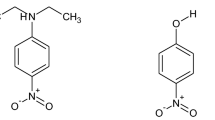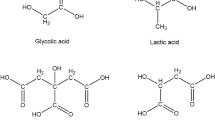Abstract
Hydroxyl-proton chemical shifts of alcohol mixtures and aqueous solutions containing some nonelectrolytes (alcohols, ketones, cyclic ethers, and amines) have been measured at 60 MHz and at 0°C. Methyl-proton resonance of the solutes was used as the internal reference and the water-proton shifts in solutions were measured with respect to pure water. Downfield shifts for some alcohols (particularly tertiary butanol and iso-propanol), cyclic ethers, and amines in the water-rich region were confirmed For alcohols and some other nonelectrolytes in water, the observed shifts were decomposed to component contributions arising from the “polar group” effect, “solute proton” effect, and “nonpolar group” effect. Polar effects are found to contribute a substantial fraction of the observed downfield shifts. After subtracting these polar contributions, however, there still remains certain amounts of downfield shifts which may be attributed to the effect of nonpolar groups on the water structure. The downfield shifts are found to be relatively large when the solutes have branched alkyl groups with nearly spherical shape and with diameters of about 5 Å. Strikingly large downfield shifts of water proton resonance were found for some secondary amines and tertiary diamines with globular shape. However, in view of the extrapolation technique employed in evaluating the “polar group” effect, the downfield “nonpolar group” effect we estimated should be considered as the upper limits.
Similar content being viewed by others
References
I. Weinberg and J. R. Zimmerman,J. Chem. Phys. 23, 748 (1955).
J. A. Pople, W. G. Schneider, and H. J. Bernstein,High-Resolution Nuclear Magnetic Resonance (McGraw-Hill, New York, 1959).
H. G. Hertz and W. Spalthoff,Z. Elektrochem. 63, 1096 (1959).
H. G. Hertz and M. D. Zeidler,Ber. Bunsenges. Phys. Chem. 68, 821 (1964).
J. Clifford and B. A. Pethica,Trans. Faraday Soc. 61, 182 (1985).
J. Clifford, B. A. Pethica, and W. A. Senior,Ann. N. Y. Acad. Sci. 125, 458 (1965).
F. Fister and H. G. Hertz,Ber. Bunsenges. Phys. chem. 71, 1032 (1967).
H. G. Hertz, inProgress in Nuclear Magnetic Resonance Spectroscopy, J. W. Emsley, J. Feeney, and L. H. Sutcliffe, eds. (Pergamon Press, London 1967), Vol. 3, pp. 159–230.
P. Laszlo in the same book of,ref. 8, , pp. 231–402.
D. D. Eley and M. J. Hey,Trans. Faraday Soc. 64, 1990 (1968).
D. N. Glew, H. D. Mak, and N. S. Rath,Can. J. Chem. 46, 195 (1968).
D. N. Glew, H. D. Mak, and N. S. Rath, inHydrogen-Bonded Solvent Systems, A. K. Covington and P. Jones, eds. (Taylor and Francis Ltd., London, 1968), pp. 197–210.
J. Reuben,J. Am. Chem. Soc. 91, 5725 (1969).
H. G. Hertz, B. Lindman, and V. Siepe,Ber. Bunsenges. Phys. Chem. 73, 542 (1969).
E. v. Goldamer and H. G. Hertz,J. Phys. Chem. 74, 3734 (1970).
J. T. Arnold and M. E. Packard,J. Chem. Phys. 19, 1608 (1951).
R. G. Anderson and M. C. R. Symons,Trans. Faraday Soc. 65, 2550 (1969).
W. Y. Wen, P. T. Inglefield, Y. Lin, and G. Minott, Clark University, unpublished results, 1971.
E. R. Malinowski and A. R. Pierpaoli,J. Mag. Res. 1, 509 (1969).
D. N. Glew, H. D. Mak, and N. S. Rath,Chem. Commun. 1968, 264 (1968).
K. Oakes, Unilever Research Laboratory, Port Sunlight, England, private communications. 1970.
E. Forslind and A. Johansson, University of Stockholm, Sweden, private communications, 1962.
A. D. Buckingham,Can. J. Chem. 38, 300 (1960).
P. Laszlo and J. I. Musher,J. Chem. Phys. 41, 3906 (1964).
P. Diehl and R. Freeman,Mol. Phys. 4, 39 (1961).
W. T. Raynes, A. D. Buckingham, and H. J. Bernstein,J. Chem. Phys. 36, 3481 (1962).
Author information
Authors and Affiliations
Additional information
Work done at Professor Hertz's laboratory in Karlsruhe on a sabbatical leave from Clark University.
Rights and permissions
About this article
Cite this article
Wen, WY., Hertz, H.G. Chemical shifts of aqueous nonelectrolyte solutions: Influence of the polar and nonpolar groups on the water proton shifts at 0°C. J Solution Chem 1, 17–37 (1972). https://doi.org/10.1007/BF00648414
Received:
Revised:
Issue Date:
DOI: https://doi.org/10.1007/BF00648414




